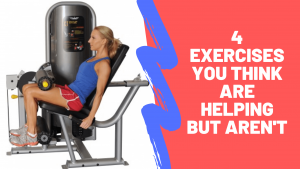Last week, we looked at how any “core strength” routine really ought to incorporate hip abductor and external rotator strength exercises, as there’s some good evidence that having strong hip muscles can prevent various leg and knee problems. But I would be remiss if I did not actually review the evidence on “traditional” core strength exercises: abdominals and back extensors.
So, in this article, we’re going to look at what the latest scientific literature has to say about the effectiveness of abdominal exercises and back extensions. Then, we’ll use this evidence to construct effectual and productive core routine to help keep you injury-free and running strong.
The Science
Despite the near-universality of crunches and sit-ups, the scientific literature is relatively sparse when it comes to the protective effect of abdominal strength. Lacking well-controlled randomized studies (the “gold standard” of preventative medicine), we have to turn to circumstantial evidence.
Abdominal strength and injury-risk
The first study we’re looking at, conducted in 2004 by Leetun et al.,1 investigated how various measures of hip and abdominal strength affected injury risk in a group of basketball and track athletes. Measurements were taken of hip, abdominal, and back extensor strength and the athletes were tracked during the course of the season. Those who suffered an injury were noted, and at the end of the season, the average strength values of the injured and uninjured groups were tabulated.
As we might expect from last week’s article, the injured runners were significantly weaker in their hip abductors and external rotators. But there was also a difference, albeit smaller and not statistically significant, between abdominal and back strength between the groups. The healthy runners tended to be slightly stronger through their trunk.
An older study, conducted in 1997 by John Orchard and colleagues2 on Australian soccer players who suffered hamstring strains found a similar outcome: When comparing strength values measured at the beginning of a season, other factors tended to be a better predictor of injury (in this case, hamstring strength), but abdominal strength had a small, statistically insignificant effect.
Core activation and running injuries
Perhaps due to the inherent strength of the trunk (compared to the hip abductors), it may be hard to see how a lack of abdominal strength could contribute to injury. However, one particularly creative study by Gorelick et al.3 attempted to solve this problem by examining the changes in trunk muscle activation before and after the back extensors were fatigued—either with a “general fatigue” protocol of using a rowing machine, or a “localized fatigue” protocol of doing back extension exercises.
The researchers used high-tech equipment to measure the muscle firing patterns when the subjects bent over to pick up a heavy object (this being more focused on work-place injuries than athletic ones). The results of the study demonstrated that there was a difference when the back muscles were weakened through a back extension protocol, but not from the rowing protocol. This is bad news for proponents of abdominal exercise for runners, since presumably running is also a “general fatigue” protocol.
The effect of core strength on balance and running performance
So, things aren’t looking all that great for abdominal and back extensor strength. If it seems like I’m grasping at straws here, that’s because I am: there is a dearth of strong studies investigating the effects of abdominal and back extensor strength on injury or performance—much more attention has been paid to the muscles of the hips.
The closest recent example was conducted in 2009 by Sato and Mokha,4 who examined the effect of a rigorous core strength program on impact, balance, and running performance in recreational runners over 5km.
While the design of the study was not particularly impressive (only 28 subjects begun the study; eight dropped out), and the runners themselves were not very good (mean 5k times were in the neighborhood of 26-28 minutes), the study found no effect of a core strength program on how hard the runners hit the ground or how good their balance was. It did, however, find a significant effect on 5k time (the experimental group ran 47 seconds faster vs. only 17 for the control). Due to the small sample size and inexperience of the runners in the study, it’s not the pinnacle of scientific research to put it lightly.
Our take on abdominal and back strength
Looking at the evidence, it’s a real stretch to say that traditional abdominal and back strength exercises are a “slam dunk” like the hip abductor and external rotator strength exercises are. However, researchers may have simply spent more time on the more powerful predictors of injury (hip strength) and not noticed a smaller but perhaps also important contribution from “traditional” core strength.
In any case, there’s nothing to suggest that crunches, sit-ups, and supermans are bad for you, and perhaps more extensive studies will discover something important about ab and back strength. For now, the benefit of these traditional abdominal exercises seem to be minimal compared to the possible benefits of a hip strength program or a core training program that targets the running specific core muscles on multiple planes.
Therefore, we suggest making more time for hip strengthening and running-specific core exercises. If you’re looking for a good program, you can download our free training routines here:
Download the
Runner’s Core Routine Here
Download the Runner’s Hip Strengthening Here
Enjoy the routines and let us know what you think of them in the comments section.





One Response
Thank you for this information. It seems that there is at best a tenuous connection between core exercises and running performance.